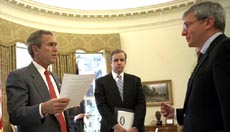
|
A Strong Record of Achievement
For the last two and a half years it has been my honor to serve as the Office of Management and Budget Controller, and assist the federal financial management community in achieving the objectives of the President's Management Agenda (PMA). Since I have recently announced my retirement, I wanted to reflect on the significant accomplishments that have been made since the launch of the PMA in 2001 and also the opportunities that are on the horizon.
Significant progress has been made since 2001, when the President issued a "call to action" for federal managers to achieve a series of critical financial management goals. As measured by the financial management PMA scorecards, which track agency progress in meeting a concise set of clear and measurable financial management performance goals, the performance of the federal government has been outstanding. In 2001, 21 of the 26 agencies participating in the Improved Financial Performance Initiative were Red, and only one agency had achieved the Green standards. Through the combined hard work of thousands of individuals, today 12 agencies have achieved Green, and 3 have achieved Yellow. Similar improvements have been made in both the Real Property and Eliminating Improper Payments initiatives. But even more important, the progress achieved on the PMA scorecards has translated into real results for the American people. Specifically:
While I believe that American citizens can be proud of this progress, I also believe they should not be satisfied with it. Much remains to be done before the government can say that it has achieved the level of financial management excellence for which we are striving. Federal managers must continue to mobilize resources and re-dedicate efforts to strengthen accounting practices, implement stronger internal controls, eliminate instances of error and waste, and use financial data to manage costs. As we set out to achieve new and better levels of performance, it is critical that the federal financial community orient itself around a common set of priorities, an agreed upon plan for action, and a clear and consistent roadmap for improvement. Specifically, we are well prepared to meet the following goals by 2011:
While these may have seemed like daunting challenges just a few years ago, today they are well within reach. As these new milestones are achieved in the coming years, I will join my fellow citizens in applauding the dedicated, qualified, and competent professionals in the federal financial management community who are working hard every day to ensure government acts as an increasingly effective steward of the taxpayers' money. |